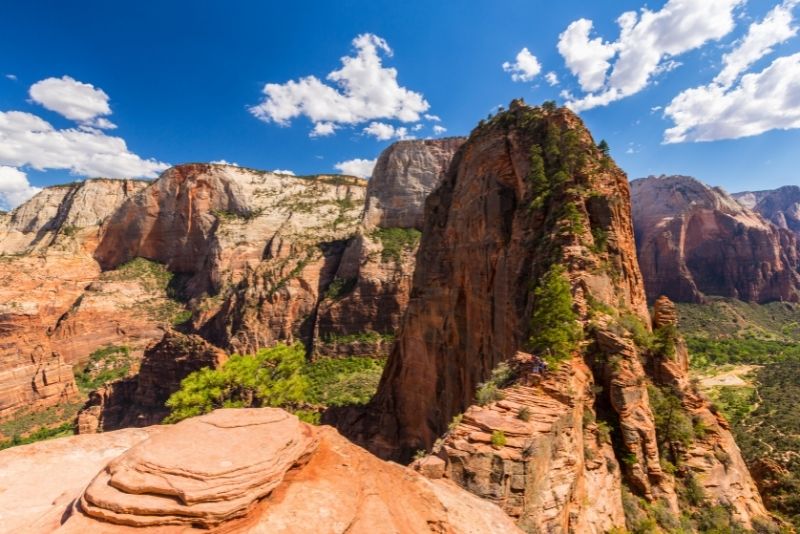Utah’s first National Park was established in 1919 and now sees over 3.5 million visitors every year. Although the 600 square kilometer park isn’t that big compared to other parks in the Western half of the country – nearby Grand Canyon National Park covers a surface of almost 5,000 square kilometers – there’s still plenty to see and do here.
The park’s cliffs and canyon walls, sculpted over hundreds of thousands of years by the Virgin River, are a beautiful red of Navajo sandstone and a major attraction here – people come from all over to hike through, explore, and photograph the canyon walls. Because of its unique location in a cold climate that also supports desert life, the park is home to a large variety of animals and plants.
For visitors looking for adventure, Zion Canyon National Park offers plenty of backcountry space, where it’s possible to lose yourself against a backdrop of some of the most stunning red mountains you will ever see.
- How to get to Zion National Park?
- How much does the entrance ticket to the Zion National Park cost?
- Do you need reservations or permits to enter Zion National Park?
- Can you visit other parks nearby?
- What are the best things to do in Zion National Park?
- What will you see in Zion National Park?
- Is it worth visiting Zion National Park?
- How many days should you spend in Zion National Park?
- What is the best time to visit Zion National Park?
- What are the Zion National Park operating hours?
- Can you drive around Zion National Park?
- How to get around in Zion National Park?
- Can you swim in Zion National Park?
- Can you camp overnight in Zion National Park?
- Are pets allowed in Zion National Park?
- Is Zion National Park Safe?
- Travel tips
How to get to Zion National Park?
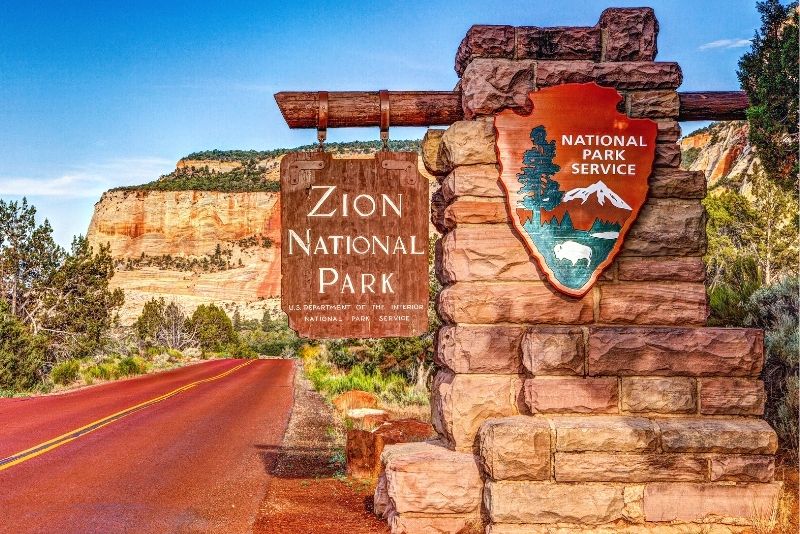
From Springdale
By shuttle
Although it’s possible to park directly at Zion Canyon National Park, the main parking lot near the Visitor Center is usually packed already by mid-morning. Even if you do have a car, using the park’s free shuttle system will make it easier and more convenient to move around.
In Springdale, you can park at any of the paid parking lots or leave your car at your hotel if you’re sleeping in town. There are also public transportation options to get you to Springdale from other major cities around the country. Then look for the nearest shuttle stop (there are nine around town) to get to the park.
Keep in mind that the shuttle bus does not run in December or January, so you will have to make different plans to get to the park during those two months.
The shuttle will drop you off at the Zion Canyon Theater near the park entrance. This is the pedestrian entrance and often moves faster than car entrances.
By organized tour
If you have limited time to visit the park, an organized tour could take the pressure off and help you make the most of your trip. No matter if you want a fun hike in the sun, an adrenaline-charged off-road adventure, or a half-day of canyoneering, there’s a tour out there for you.
Some of the most popular tours include half-day Jeep tours that take you to explore the rugged landscapes of the park. These tours include driving on desert trails and stopping along the way for great photo opportunities. Half-day canyoneering tours are also popular, where guides take visitors to rappel down canyon walls and hike between towering walls.
There are also helicopters tours that take you on a panoramic flight over the stunning red canyons and wild rivers that call the park home. You’ll cover over 56 km of the park in just 20 minutes while learning about the history of the area. Plenty of hiking tours are also available no matter your fitness level and how many hours you want to spend seeing the main landmarks and exploring off the beaten path.
All tours will pick you up either at your hotel in town or a designated spot, and then drop you back at the end of the day, solving all your transportation issues.
From Las Vegas
By car
If you’re planning on staying at least one night at Zion National Park, driving there could be a great idea. It gives you lots of flexibility, including a chance to stop along the way for great photo opportunities and maybe an additional hike or two.
Zion National Park is about 257 km away from Las Vegas. That’s about a three-hour drive on the I-15 heading north in good traffic conditions. You’ll actually pass another great park on your way, Valley of Fire State Park. If you have some extra time, it’s worth stopping here for a visit. Valley of Fire is renowned for its 2,000-year-old petroglyphs carved on rust-colored sandstone formations.
Along the way, you’ll also drive by the scenic Virgin River Gorge, a 16 km stretch where the highway runs parallel to the Virgin River. The two-lane road is very tight and a bit unnerving as cars fly by very close to you, but the views over the water are worth the adrenaline rush.
You can park the car directly at the entrance, but keep in mind that during high season, the parking lot is full by mid-morning. Another option is to park in nearby Springdale and take the free park shuttle. The shuttle will drop you right at the entrance, where you can buy a ticket and walk into the park. There’s another free shuttle you can use to explore the park.
By bus + shuttle
If you don’t have your own car or feel like renting one, there are also direct buses from Las Vegas to the park. Long-distance buses end their route at St. George, Utah, a large city against the Mojave Desert.
The two largest companies covering this route (in just over two hours) are Greyhound and Flixbus USA. These are comfortable buses with restrooms, Wi-FI, and outlets onboard. Many also offer refreshments.
The National Park Express is a shuttle service that covers the same route. Buses are somewhat more modern and have more legroom but otherwise offer a very similar service to Greyhound and Flixbus. One big advantage of the shuttle is that it has several pickup points in Las Vegas (including some of the major casinos), so you don’t have to go out of your way to find them.
There’s also the Salt Lake Express, which leaves from Las Vegas Airport and covers the same route.
Once you arrive, you can take the St. George Shuttle straight to the park’s entrance. Keep in mind that the shuttle only runs four times a day and the journey takes about an hour. Arrive as early as possible in the morning to make the most of your day at the park.
By organized tour
Don’t want to worry about schedules and whether you’ll have enough time to explore Zion National Park? Arranging a guided tour allows you to just sit back, relax, and enjoy the stunning views and dramatic wilderness.
There are plenty of tours that depart from Las Vegas and take you to Zion. Many even combine the visit with stops at other parks, so you can get the best of the area in one trip. All tours pick you up at either your hotel or a designated spot on The Strip, so no worries about finding your driver and getting somewhere on time.
Popular options include full-day tours (13 hours long) that combine visits to Zion National Park and Bryce Canyon National Park in one day. You’ll experience the top sights in each place, including the scenic drive in Zion and a hike into Bryce. If you want more of both parks, there’s also a two-day tour that covers the same parks, so you can hike the famous Angels Landing and jump into the river as you hike deep into the canyons.
Want even more? There are 3 and 7-day-long tours also available, which extend to cover additional parks and experiences, including guided jeep tours, flying over the Grand Canyon in a helicopter, a BBQ around a campfire, and even a chance to visit a Wild West ghost town.
Hot tip: Find out about the best Zion National Park tours from Las Vegas for a day of stunning landscapes and tranquility.
How much does the entrance ticket to the Zion National Park cost?
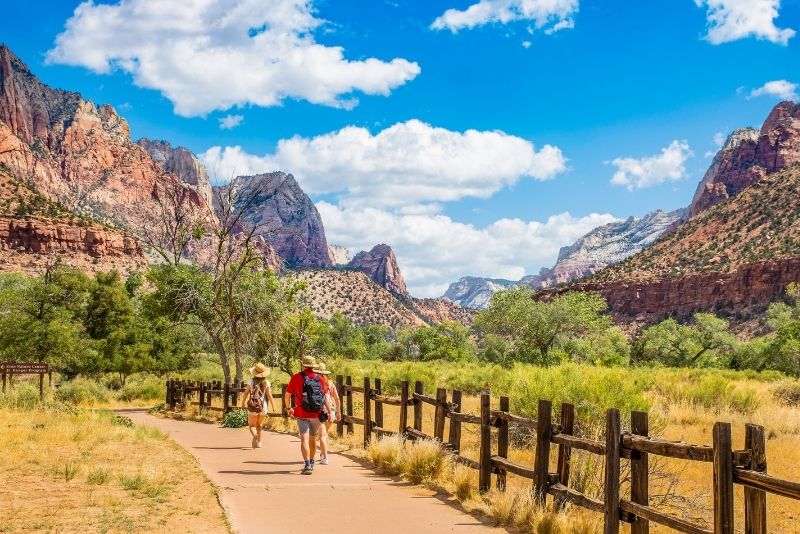
Entrance Fee
A recreational use pass (entrance tickets) is required to enter Zion National Park. There are three entrances to the park and you can use any of them to purchase tickets. All accept credit and debit cards. Keep in mind that only the South entrance has a visitor center where you can pick up maps and other things. Passes are non-transferable.
Weekly Passes
There are no daily tickets available for the park. The cheapest ticket available allows you entry to the park for up to a week. Weekly passes are valid for 7 consecutive days starting on the day of purchase.
- Private Vehicles: $35
Any private (non-commercial) vehicle with up to 15 people onboard can get a weeklong pass for a single price of $35. This is the cheapest option available, as it covers an entire family or even a large group of friends traveling together.
- Motorcycle: $30
Admits one motorcycle (and 1-2 riders/passengers)
- Per Person: $20
Hikers, pedestrians and those riding a bike will need to get this individual permit. Children under 15 can enter the park free.
Annual Passes
If you’re planning on spending longer than a week in the park (or want to return at a later date), an annual pass offers big savings. For $70, a single adult can get admission to Zion National Park for one year from the date of purchase.
Do you need reservations or permits to enter Zion National Park?
An entry ticket to Zion National Park gives you access to the entire park, but there are special permits and reservations required for certain activities within the park. Make sure you obtain these in advance, as many are offered in limited quantities and are likely to sell out in high season.
Backcountry and Wilderness Permits
Permits are required for all overnight stays within the park (outside of campgrounds) and to access areas away from designated trails. For example, if you plan on using gears and rope to explore canyons or want to sleep under the stars near the Virgin River, you’ll need a special backcountry permit.
You will also need a wilderness permit to hike the Left Fork of North Creek (Subway) area. You can apply for a lottery ticket as far as two months in advance or try a last-minute drawing up to two days before your trip.
Some permits (including for any spaces not taken through the lottery) can also be obtained at the Visitor Center, so you will need to use the South entrance to the park.
Permits cost $15 for 1-2 people, $20 for groups of up to 7 people, and $25 for 8-12 people. These are in addition to the park’s entrance fee.
Angels Landing Permits
Angels Landing is a 454-meters tall rock formation with a steep, difficult and not-for-the-faint-of-heart trail cut right into it. Although the trail itself is only 3.8 km one way, it has an elevation gain of 457 meters, which makes it fairly strenuous. A hike up can take several hours.
Starting in April 2022, a special permit is needed to climb Angels Landing. This is to avoid congestion on the trail and help reduce risks. Permits will be given out on a lottery basis and the easiest way to apply is to do it the day before your arrival at the park.
The application window is open only between 12:01 a.m. and 3 p.m. MT. So if you want to go hiking on a Saturday, you will need to apply between those times on Friday and you will be notified of the lottery results at 4 pm that same day. If you win, you’ll be charged $3 for the permit.
There are also seasonal lotteries if you want to apply several months in advance (for example, you must apply in April for June-August hikes) but this makes planning harder if you have a specific travel date already selected.
Can you visit other parks nearby?
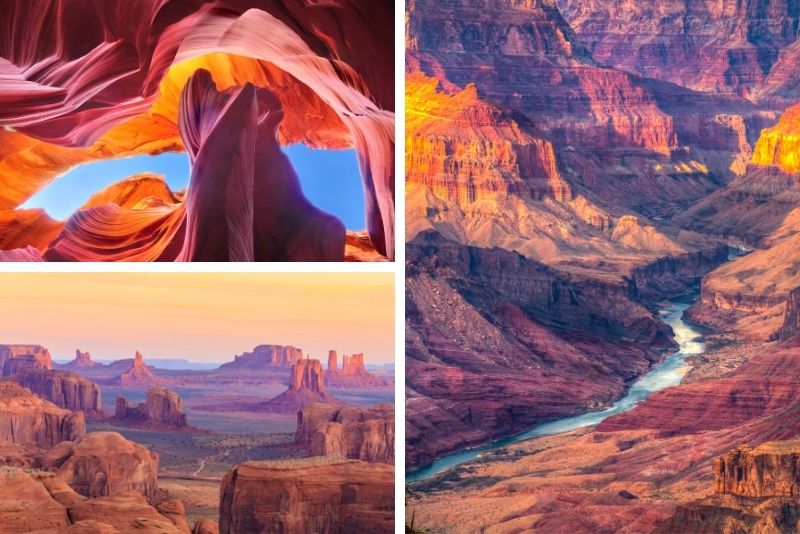
Utah is home to some spectacular canyons. With stunning views and once-in-a-lifetime hikes, it’s worth seeing as many parks as you can when visiting here. Zion National Park is close to many other destinations, so why not organize a little road trip to explore Utah’s unique beauty?
Bryce Canyon
Just 115 km and an hour and 15 minutes from each other, Zion National Park and Bryce Canyon are the easiest parks to combine as a one-day trip.
Bryce is well-known for being the park with the largest concentration of hoodoos or “fairy chimneys” (a thin rock spire at the top of basins and other arid lands) in the world. This gives the giant red, orange, and white natural amphitheaters and plateaus at Bryce a very unique, otherwordly look.
The easiest way to explore Bryce Canyon is to take the scenic drive, which offers over a dozen stunning viewpoints along the way. There are also marked hiking trails, as well as 16km of skiing trails, and wrangler-guided horseback rides. Bryce Canyon has one of the darkest skies in the country – which makes it one of the best destinations for stargazing. On an average night, you can see close to 7,500 stars in the sky here, compared to less than 50 in a large city.
Antelope Canyon
Antelope Canyon is just under two hours from Zion National Park and is unique for one unusual reason – it can only be visited as part of a guided tour. This is because the canyon is located on land that belongs to the Navajo Nation and is considered a sacred site.
The intense orange color of the canyons together with the beans of light slipping through the slot canyon sections make the area a photographer’s dream.
The park has two canyons: the Upper and the Lower Antelope canyons. The upper canyon makes for a fairly easy hike, while the lower canyon is a little more strenuous and includes some metal stairs, soft sand, and ramps. The canyons don’t connect with each other so if you want to catch the best light and colors, you should hike both.
Monument Valley
At 371 km and almost four hours away from Zion National Park, Monument Valley is best explored as part of a multi-day trip. Located on the border between Arizona and Utah, this park is also part of the Navajo Reservation.
Although you don’t need a tour guide to explore this park, having one will help you better understand the history of the area and the land.
The easiest way to explore here is to drive the 27-kilometer loop, a scenic road that takes you past towering sandstones that can reach 300 meters tall. Framed by clouds, the cliffs offer great photo opportunities and plenty of chances for short hikes.
Grand Canyon
There’s a reason everybody knows the Grand Canyon – at 446 km long and over 1,800 meters deep, it’s a sight to behold. Located just under two hours from Zion National Park, the Grand Canyon is so vast that it would take several days to really explore it.
Rafting, hiking, helicopter tours, and mule tours are all popular here. So it’s overnight camping under the stars, though this requires a backcountry permit.
The Grand Canyon Skywalk, which extends over the edge of a canyon 350 meters up in the air, is now one of the most visited attractions within the park.
There are plenty of amazing short day hikes here, including the very popular Rim Trail, which offers great views over the inner canyon. But the ultimate hike is for sure the one to the bottom of the Grand Canyon.
The hike is 15 km one way but the terrain is rough and slippery, so even walking down into the canyon can take up to 4 hours. Most hikers camp overnight at the bottom of the canyon before braving the 1,300 meters of elevation change the next morning. Depending on fitness level, this can take anywhere from 5 to 9 hours.
What are the best things to do in Zion National Park?
While most people visiting Zion have hiking in their minds – and who can blame them, with picture-perfect hikes like The Narrows available – the park has plenty of other things to offer to those looking to escape the hustle and bustle of city life.
Biking at Pa’rus Trail
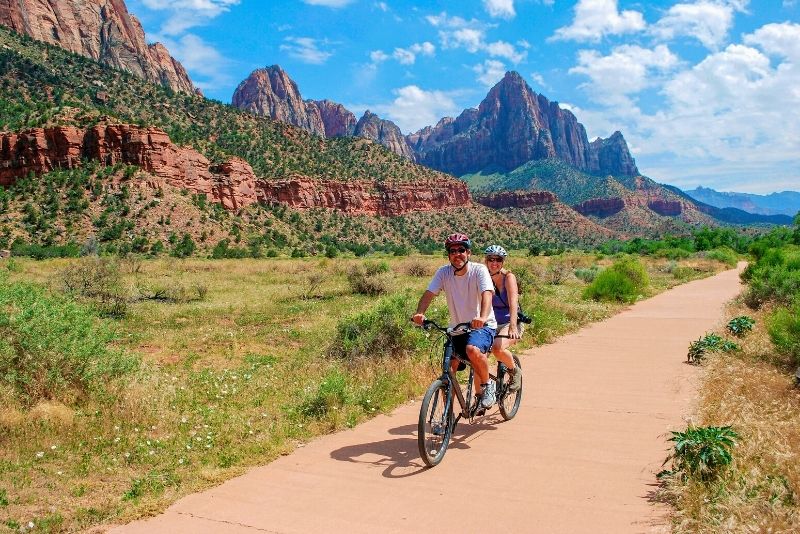
The Pa’rus Trail is one of the easiest ones in the park. It’s paved and it welcomes dogs – and it’s also perfect for a leisure bike ride. The trail is around 5.5 km long, almost completely flat, and starts right at the Visitor Center, so it’s even doable for families.
As it passes by the Virgin River, meadows, and a couple of charming footbridges, it also offers plenty of spots for stunning photos along the way.
Bikes are also welcome on all park roadways (but not trails except for the Pa’rus Trail). For example, bikes are allowed on the Zion Canyon Scenic Drive even during high season, as well as the Zion-Mount Carmel Highway and the Kolob Canyons Road.
Bird watching
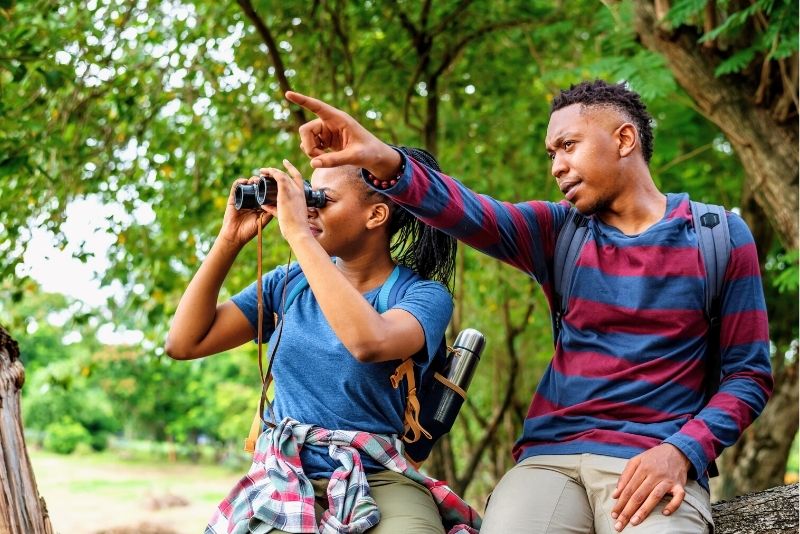
From the rare California Condor to the American Coot overwintering in the park and the native Canyon Wren, almost 300 species of birds call the park home.
The incredible diversity means plenty of opportunities to catch sight of something in flight, no matter when you’re visiting.
Hiking is one of the best ways to spot wildlife, and this also applies to birds. Pack some binoculars and look for the birds soaring over the canyons as you walk.
Jeep tour

The area around Zion National Park is a great place to explore with a Jeep or ATV tour. You’ll get to see a completely different side of Southern Utah, driving to the most dramatic viewpoints in the park, catching golden sunsets, and exploring off-road paths as you discover the dramatic cliffs and abundant wildlife.
Tours cater to the casual driver or the adrenaline-inspired, as well as those who want a couple of hours riding under the sun and those who want to overnight under the stars.
Either way, you’ll get to experience the rugged and remote region with a guide who knows the landscape well and can share fun information and forgotten tales about the park and those who once lived there.
Helicopter tour
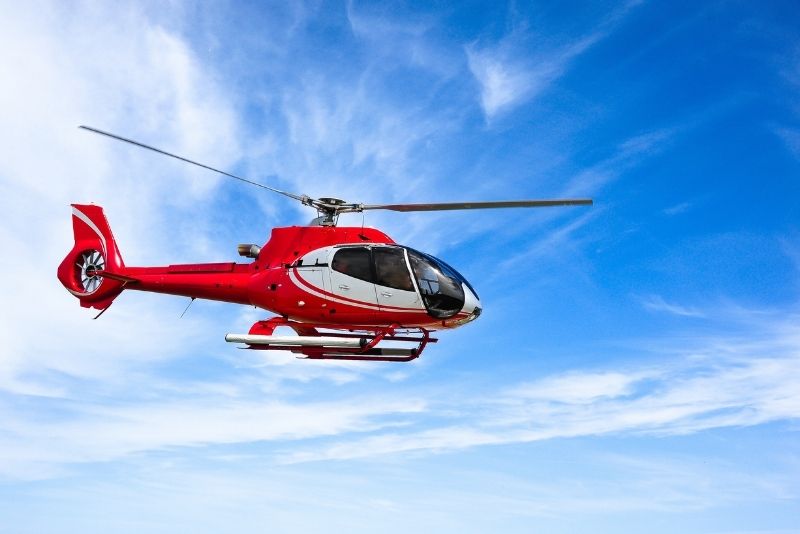
If you only have one day to see Zion Canyon, there’s no more awe-inspiring way to experience it than from above. You’ll be able to take in the scenery and catch stunning views of the red cliffs as you fly over the Virgin River valley, the West Temple, Kolob Canyon, and even the Crater Hill Volcano.
Let your pilot take your trip to completely new heights as you soar over the mountains and mesas, discovering the geology of the area from a completely new perspective. The towering cliffs and world-famous views of West Zion will never look more stunning than when you see them from the air, away from the crowds and are able to experience their true grandeur.
Helicopter tours are available for short flights or long flights, so you can cover the most beautiful sights in just 24 km or keep exploring awe-inspiring views of nearly every angle of Zion with a 160 km long flight. Either way, you’ll get amazing photo opportunities of the iconic red formations below.
Canyoneering
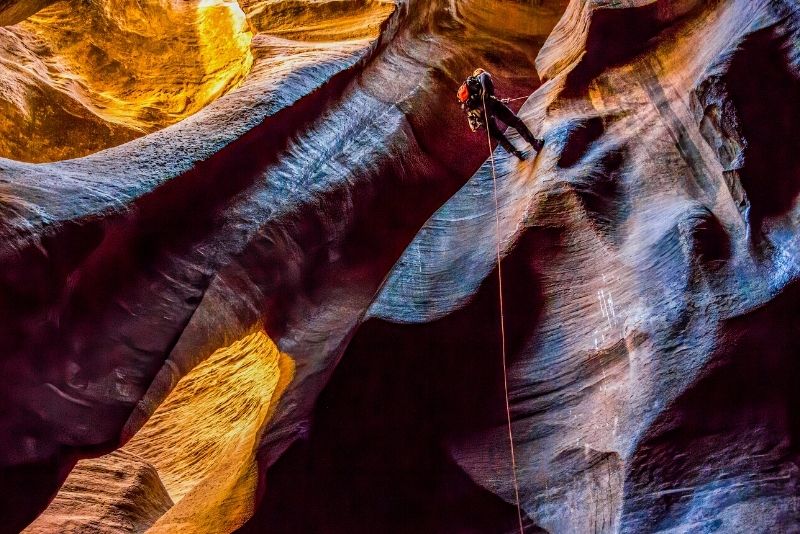
The sport of canyoneering allows you to explore canyons using a variety of techniques – from hiking to rappelling to sliding and chimneying. While it might all sound extreme, canyoneering is very safe when you use the proper equipment and are exploring in a controlled environment.
Zion is a great place to try canyoneering, as the area offers both manageable walls for beginners and incredible towering cliffs for intrepid explorers and climbing veterans.
All canyoneering trips in Zion require a wilderness permit, as you would need to travel into backcountry areas away from marked trails.
The Narrows is a great place for less experienced adventurers to discover the adrenaline-charged fun of the canyons, while the Subway and Orderville Canyon offer more experienced routes that require swimming and rappeling to get through.
For those with technical experience, Pine Creek is Zion’s most challenging canyoneering destination, with plenty of serious obstacles along the way.
Horse riding
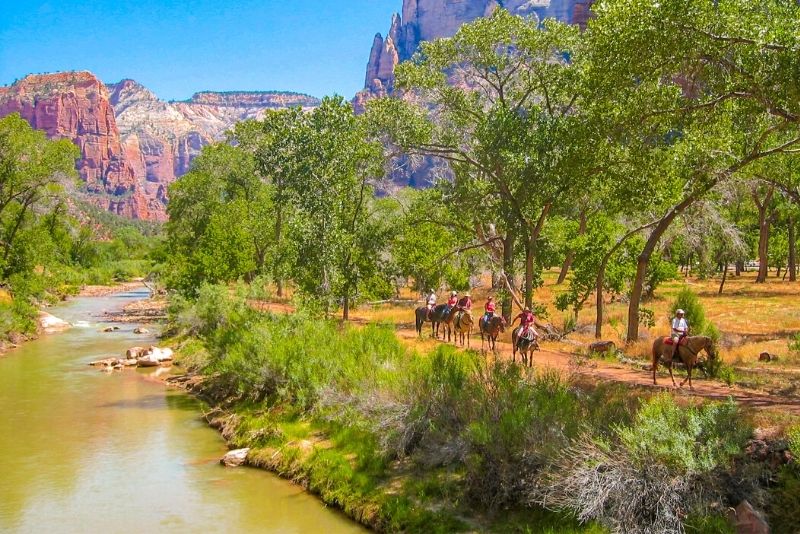
Horseback riding tours are a great way to explore off-the-beaten-path and get to places where shuttles and cars cannot reach. Whatever your riding experience, there’s a tour out there to fit your needs and the rewards are truly worthwhile – friendly guides, gentle animals, and natural wonders all around you.
If you just want a short introduction to riding, one-hour rides will take you along the Virgin River, bringing you to the Court of the Patriarchs.
For more experienced riders, the three-hour rides offer an opportunity to discover the 5.6 km long Sand Bench Trail, which offers a gradual 60-meter ascent to the top of the sand bench for great views over Zion and the surrounding landscape.
Craving more adventure? Some tour operators offer sunset rides or take you to the Pine Grove trail for a ride through the desert forest and sweeping views of Southern Utah.
Rock climbing
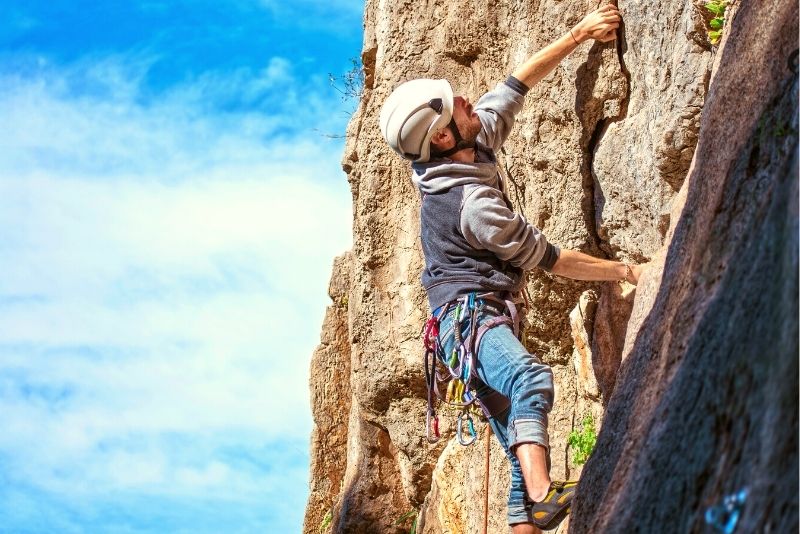
Climbing in Zion National Park is not for beginners and certainly not for the faint of heart. With soft sandstone cliffs that can reach over 600 meters high, most routes – favorites include the Great White Throne mesa and Isaac Peak – here require some technical knowledge to maneuver underclings, lay-backs, and traverses.
Because you can climb almost anywhere in the park, permits are not required for day climbs, but you’ll have to obtain one if you plan on overnight stays in the backcountry.
If you’re up for giving climbing a try but lack the experience, a guided trip is the best option. Paid guiding for climbing routes is not allowed within Zion National Park, but local outfitters can help you learn the basics in beautiful locations right outside the park.
See also: Fun Things to Do in Zion National Park
What will you see in Zion National Park?
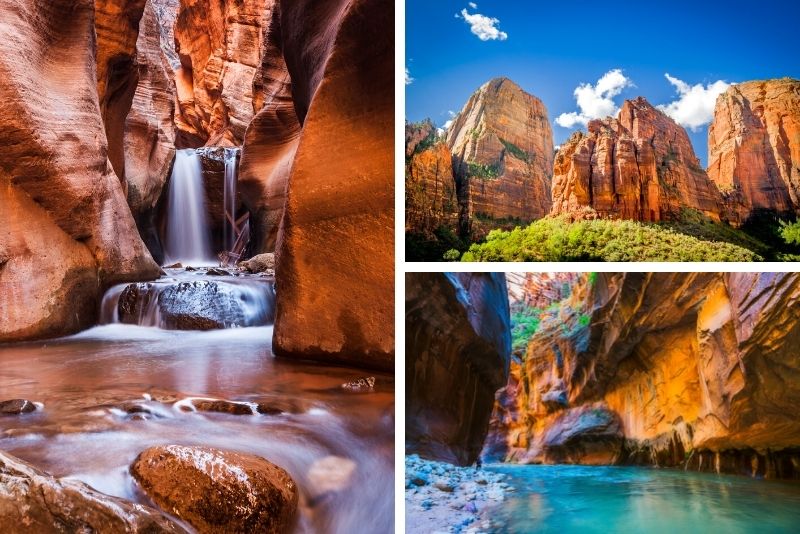
There’s plenty to see in Zion National Park – the beauty of the sandstone cliffs, the always blue skies, and some of the most beautiful canyons you’ll find anywhere. Here’s just a taste of what you’ll see when you visit the park.
The Narrows
As the name suggests, The Narrows is the narrowest gorge at Zion Canyon National Park. In some areas, the bottom of the canyon is just six meters wide here, with the Virgin River touching both sides of the canyon walls. What this means, simply put, is that hiking The Narrows means walking right in the river, as there are no trails to get you through otherwise.
The Narrows hike can be short or long, depending on how far you go. Most people start their hike at the Temple of Sinawava, the last stop on the park’s free shuttle. If you hike as far as Big Spring, the entire walk is about 15km roundtrip, but you can turn back anytime and make the hike shorter. There’s no big payoff view at the end of this hike so you won’t miss out – the beauty of it is in the walk itself, surrounded by colorful sandstone.
Although the hike is accessible all year long, the water can be very cold in winter, and walking in the river chest-deep would be miserable.
Emerald Pools
If you’re looking for a relaxed, family-friendly trail in Zion Canyon, this is it. Emerald Pools is actually a series of short connecting trails that run alongside a water stream, forming pools. If you hike all the sections of the trail, you’ll walk around 3.2 km, but it’s possible to just turn around at any time.
The trail starts at the Zion Lodge shuttle stop and the first section includes two waterfalls and a tall alcove you actually walk under. The middle section of the trails is actually the most challenging but also the most beautiful, with views of the pools where the waterfalls originate and lots of lush vegetation. The last section of the trails gets you to the final pool and offers space to sit back for a break or even have a picnic.
Depending on how fast you’re walking, the entire walk might take up to four hours, but it’s very doable even if you’re not an avid hiker.
Angels Landing
The views from the top of Angels Landing are truly worth the pain it takes to get there. You’ll get open vistas right over the canyon and the rock formations all around.
The trail itself is only 8 km long but it’s very steep (the elevation change amounts to 453 meters) and very tricky to maneuver. Because of this, it takes 4-5 hours to complete the trail. In addition to 21 steep zig-zags known as “the Wiggles,” the trail also features very tight stone steps – at its narrowest, the path is only 1.5 meters wide, with chains on one side to serve as a handrail and very big drop-offs into the canyon below on the other side.
While the trail is open all year long, ice and snow can make the steps very slippery in winter. In summer, your biggest worry will be the heat – there’s no shade protection on the trail and temperatures can sore into the high 30s during the day.
Starting in 2022, hikers need to apply for a permit to hike Angels Landing. The permits are given out on a lottery basis, and you will have to apply either months in advance or the day before your hike for a last-minute chance to win. This is to keep the trail safer for everybody and prevent overcrowding.
Temple of Sinawava
The Temple of Sinawava is Zion Canyon’s most magnificent area, a 910-meter deep red and brown amphitheater that marks the beginning of the park’s canyon. You get there by taking the Riverside Walk, a 3.2 km roundtrip hike that offers some of the most stunning views in the park, taking you deep into the 1,000-meter-tall canyon and almost guaranteeing encounters with wild turkeys and squirrels along the way.
Small waterfalls and cascading gardens adorn the walls of the canyon, making for some stunning views and even better photographs. In summer, you can dip your toes in the river to cool off or just sit near to catch some of the cool fresh air.
To get here, simply take the free shuttle and get off at the last stop. You’ll see signs for the walk right away. Just follow the paved trail past wildflowers and red sandstone cliffs to get to the canyon.
Zion Human History Museum
Housed in what once was the original Visitor Center, the Zion Human History Museum is a great first stop in the park. Before you set off to explore the beauty of the park, why not spend some time learning about its history as well?
The park was already a national monument in 1909 but it wasn’t until the construction of a highway in the 1930s that tourists started arriving in large numbers. A stop by the museum will give you a nice background of how the park became such a popular destination, the original people who once called the park home, and the impact of Mormon pioneers in the development of the area.
Visitors can watch a documentary about the history of the park, learn about the geology of the area, and ask rangers questions. There are often temporary and rotating exhibits as well, covering topics such as conservancy and notable people involved with the park.
The museum’s bookstore also sells maps, posters, and a number of themed souvenirs.
Is it worth visiting Zion National Park?
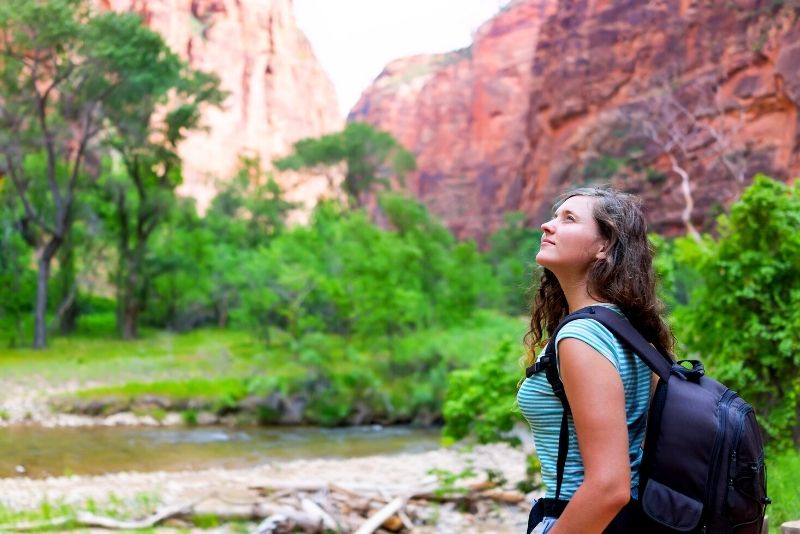
There’s no question that Zion National Park is stunningly beautiful. The striking canyons and the reddish rock formations alone make this a place worth putting on your bucket list. But the park is also home to plenty of other attractions and activities that make it worth visiting – possibly more than once.
Stargazing
Because there’s almost no light pollution at the park, the stars put on a breathtaking show once the sun goes down. If you’re camping or sleeping in the wilderness here, this alone is enough of a reason to visit the park.
Outdoor activities
Let’s just say you won’t run out of things to do at the park. Sure, hiking and backpacking top the list here, with trails that cut through canyons, deserts, and open fields and valley floors – some half an hour long, some eight hours.
But Zion National Park has also become a popular destination for canyoneers – though a special permit and gear are necessary to venture into the wilderness here. There’s plenty more to do here. Visitors can also go horseback riding, climb the towering sandstone cliffs, try challenging climbing adventures, or bike through the park.
The beauty of Zion Canyon is always changing
Arrive during the rainy season and you’ll find waterfalls in the park and river-filled canyons. And the power of the Virgin River is forever sculpting the canyon, changing its form and showcasing the power of Mother Nature.
How many days should you spend in Zion National Park?
Zion Canyon National Park has enough adventure to offer to fill an entire week – so whether you stay one night or many more will mostly depend on what you want to do there.
Summer visitors will likely stay longer, as they can go into backcountry trails, swim in the river, and hike through The Narrows. In winter, the lodge offers plenty of comfortable accommodation but when the weather gets really cold, anything water-related (a major part of many of the attractions here) is likely out of the question.
Because it’s so close to Las Vegas, the park can work as a day trip. If you have a permit for Angels Landing, that’ll be a great way to spend a few hours, followed by a break at the lodge for a quick bite, some photos at the Canyon Junction Bridge, or a visit to the museum. If you didn’t win a permit, you can try a different hike. More than one hike in a single day is hard, especially in the heat of summer, so don’t over-commit.
If you’re ready to spend a night (or a few) at the park, the best option is to make a list of everything you want to see or do and calculate how much time you need. The Narrows is a must for one of those days, but if you have a backcountry permit, you can actually hike it backwards (from the top down) which usually requires a night at the bottom of the canyon before venturing back up the next day.
If you’re staying several days, consider planning short and long hikes on alternate days. This gives you (and your legs) some chance to rest. Remember not to schedule the harder hikes – like an overnight backcountry trip of the West Rim Trail – at the end of your stay, when you’ll be more tired.
What is the best time to visit Zion National Park?
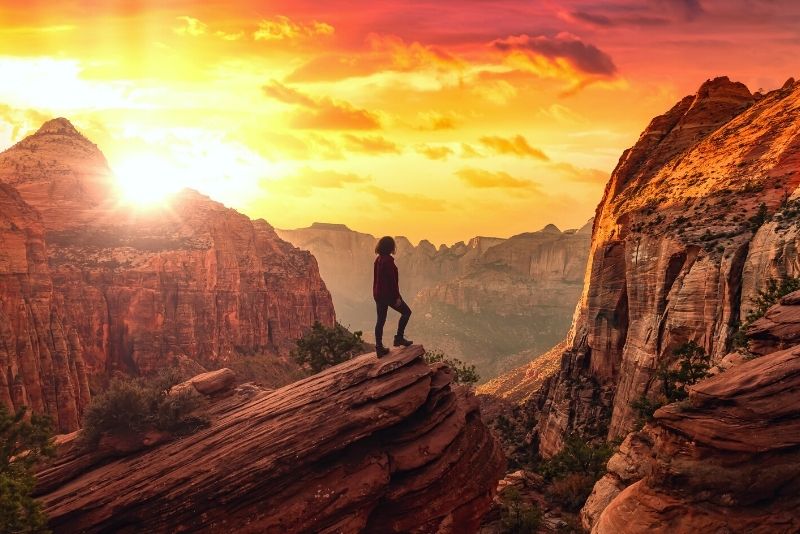
Zion National Park is open 24 hours a day, 365 days a year. And because the park is so popular, you will always find tourists here. Still, there are some times that are better to visit the park because of the weather, availability of services, and the size of the crowds.
The park has two seasons.
High Season: April to November
Visiting during the high season has its pros and cons, so you should check your expectations when choosing this period. Except for June-August, high season offers the best weather. It’s warm, doesn’t rain much, and you’ll get plenty of sunny days to explore (which also means great photos as the sun bounces on the colorful rock formations). The park’s free shuttles also run every day during this period.
On the other hand, high season means much bigger crowds, busier trails, and fewer chances of winning the permit lottery for things like backcountry permits. Also, the summer months see temperatures in the upper 30s and sometimes in the 40s (which make hiking very difficult) as well as a higher risk of flash floods in the canyons.
Low Season: December to March
The park is very cold in winter (you can expect temperatures around 0 degrees Celsius or even in the negative) during the winter, so anything related to water or sleeping outdoors is basically off-limits.
The campgrounds are also closed during the winter, but the area hotels are much cheaper than they would be in summer. Also, shuttles either run on a very limited schedule or not at all during the low season. The biggest plus of the low season is smaller crowds.
What are the Zion National Park operating hours?
The park is always open, every day of the year. But the Visitor Center and the Zion Canyon Wilderness Desk (where you can get your wilderness permits) only operate from 8 am to 5 pm, seven days a week.
Shuttles run every day from March to November, though starting and ending hours depend on the month. During December, the shuttle only runs for one week between Christmas and New Year. There’s no shuttle in January at all and during February and March, the shuttle is only in operation during weekends.
Keep in mind that cars are not allowed on the Zion Canyon Scenic Drive at any time that the shuttle service is in operation. So if you want to experience the scenic beauty of the drive from the comfort of your own car, you’ll have to visit in winter.
The park’s campgrounds and Human History Museum are closed during the low season as well.
Can you drive around Zion National Park?

Driving to the park in your own vehicle? Once you get there, you have a choice to make. You can leave your car in the parking lot and use the park’s shuttle system, or you can make your way into the park with your own vehicle.
Between March and November, the Zion Canyon Scenic Drive is not open to private cars. This is the park’s main road with the most stunning views, so missing out on it would be a shame. If you visit between December and February, though, you definitely want to drive into the park, as this is the only way to take the scenic drive during these months.
There are two other scenic drives within the park that are always open to cars: the Scenic Byway from Highway 9 to Mt. Carmel Junction and the Kolob Canyon Road.
The Highway 9 drive cuts right through the heart of the park. For about 16 km, it offers perfect views of some of the most important landmarks, passing along switchbacks, the Zion-Mount Carmel Tunnel, and the Canyon Junction Bridge.
The Kolob Drive is only 8 km long but it crosses through a less-visited section of the park. Stop along the way to explore the quiet trails and enjoy the views of waterfalls and canyons.
The entire park has a maximum speed limit of 56 kph, but some areas might require slower driving. Pay attention to signs and respect the rules – the speed is radar-enforced and you will be fined heavily if you speed. Also, be on the lookout for animals. Mule deer are known to run into the road and cause accidents.
How to get around in Zion National Park?
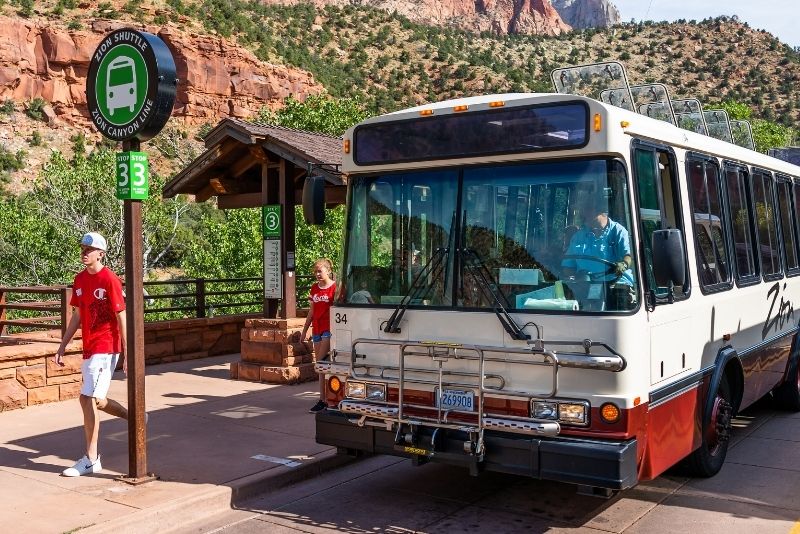
Visiting Zion National Park might seem impossible without a car, but the park’s well-established shuttle system actually makes it very easy and convenient to move around. The shuttle system consists of two lines.
The first line, the Springdale Shuttle, picks up passengers in the town of Springdale and brings them to the park’s entrance.
The second shuttle line is the free Zion Canyon Shuttle, which works as a guided hop-on/hop-off tour bus inside the park. This means you can get off at any stop and spend time exploring, then take the next shuttle that comes along to continue the trip. During peak hours, shuttles arrive at any stop every 6 minutes, so you never have to wait long.
This Zion Canyon Shuttle runs from late March to late October/early November (make sure you check the park’s official website to find the opening and closing times for the season). The shuttle leaves from the Visitor Center near the Springdale entrance and makes eight stops along the way:
- Zion Museum: The Zion Human History Museum chronicles the history of pioneer settlements in the area and how the power of water has shaped the canyons and rocks here. There are restrooms here as well as great views of the Bridge Mountain Arch.
- Canyon Junction: The stop is right near the entrance to the Zion Canyon Scenic Drive. During the months when the shuttle is operating, cars are not allowed to take the Zion Canyon Scenic Drive so you must take the shuttle to experience it.
Court of the Patriarchs: Named after the beautiful viewpoint you can access from here. - Zion Lodge: Located halfway in the shuttle loop, this is a good stop to catch a bite (there’s a restaurant at the lodge), use the restrooms, or join one of the two daily guided horseriding tours on Sandbench Loop. The Emerald Pools trail – popular because it runs alongside a stream and offers plenty of lush vegetation and shade – also starts here.
- The Grotto: If you have a permit for the Angels Landing hike, this is where you should get off. This stop also gives you access to the West Rim Trail, which ends with a descent into Zion Canyon and stunning views. This trail is better as an overnight hike as it’s fairly strenuous but could be done in one day if you start early in the morning.
- Weeping Rock: Plenty of beautiful hikes start here, including Weeping Rock, Hidden Canyon, and Deertrap Mountain.
- Big Bend: Stop here for a great view of Angels Landing and easy access to the river to cool off during the summer.
- Temple of Sinawava: Another great river access stop and the start of the Zion Narrows Day Hike along (and often in) the Virgin River.
Can you swim in Zion National Park?
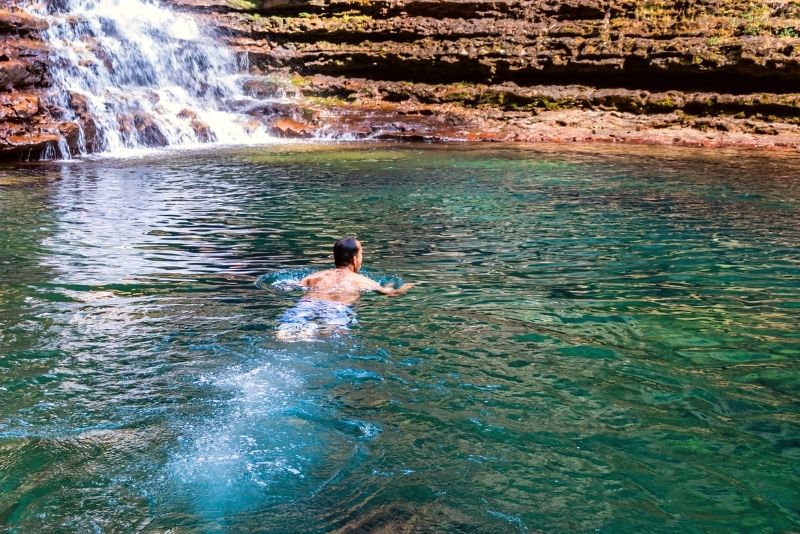
With temperatures reaching close to 40 degrees Celsius in the summer, being able to jump into the water to cool down sure sounds like a great idea. At the park, this can be easily done in the Virgin River and its tributaries that run through the park.
A great spot to try is right by the Canyon Junction shuttle stop. Walk towards the river until you find some cement ruins – these belong to an old dam and their location has created a sort of water pooling, making the area a bit deeper and perfect for swimming.
Canoeing and tubing in the river are not allowed. Neither is swimming in Emerald Pools. If you’d like to try some water sports, you can head to Springdale, where the river is open for tubing.
Cyanobacteria toxins have been found in the Virgin River in the past. This is often in the form of harmful algal blooms and can cause serious illness and potentially death if ingested. The park keeps track of the affected areas, which are mostly found on the North Fork of the Virgin River. You will find signs not to swim or touch water that could be contaminated, and the park’s official website also has additional information on areas to avoid.
Can you camp overnight in Zion National Park?
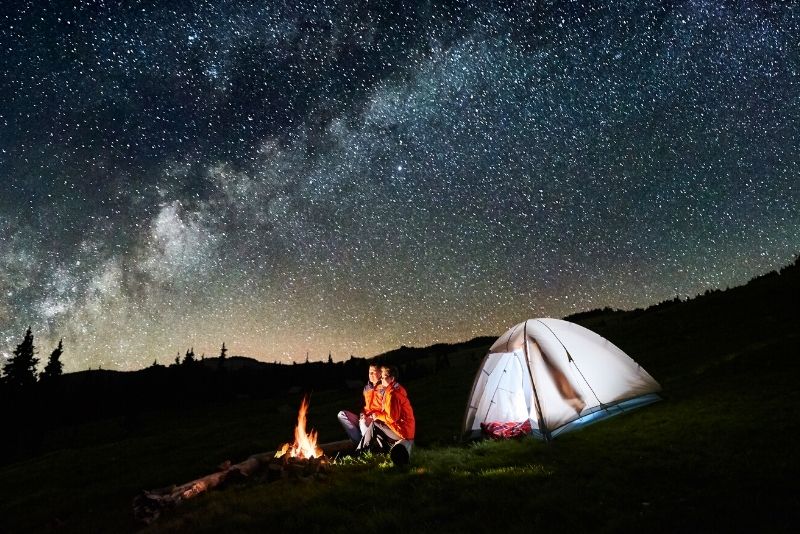
The beauty of Zion National Park cannot be truly discovered in just one day. Staying overnight at the park allows you to have more time to explore around, but also gives you a peek into the magic that the canyon has to offer at night, as silence takes over the desert and you have only the bright stars above for company.
The park has three campgrounds: Watchman Campground, South Campground, and The Lava Point Campground. Only Watchman is open year-round, while the other two are closed in winter.
Watchman Campground, located close to the South Entrance is the largest, with 176 sites that can accommodate either tents or RVs. Each site has its own picnic table and fire ring and 95 of the sites also have electrical hookups. There are flush toilets available in this campground.
The South Campground is slightly smaller with 117 sites, but it offers no electric hookups.
The Lava Campground is 7890 feet above sea level, far from the South Entrance (almost 90 minutes away) and only offers six primitive campsites available. If you’re looking for remote and “natural,” this is it. No regular flushing toilets here (only pit toilets) and you must take precautions to keep your food well stored at night to avoid encounters with wildlife.
All three campgrounds require reservations in advance and are usually completely full all-year long – so book early if you want to secure a spot.
- Backcountry camping
If you have a wilderness permit and are heading out deep into the park, you will have to sleep somewhere at some point. Backpackers are not allowed to just set their tent anywhere they want, and must find the designated wilderness campsites to stop for the night.
Many of these primitive sites require a reservation and will fill up quickly during the high season. Keep in mind that the sites can be hard to find, so you should obtain a map in advance from the Visitor Center or the park’s official website to help you locate them.
There are 10 camping spaces near La Verkin Creek Trail, two campsites near Hop Valley Trail, and designated sites near the West Rim Trail and the Southwest Desert Trails. Some areas, like the Wildcat Canyon and Connector Trails, have no established campsites. In this case, backpackers are allowed to set camp near the trail.
Are pets allowed in Zion National Park?
Traveling with your dog? Many national parks welcome dogs in certain areas, and Zion National Park is no exception. It’s important to keep in mind, first of all, that dogs should always be on a leash no longer than 1.8 meters while inside the park. Running loose is not allowed, as dogs can stress or harm wildlife.
In addition, dogs are only allowed in certain developed areas of the park. This includes the Pa’rus Trail, along public roads, in picnic areas, at the park’s campgrounds, and the area around the Zion Lodge. They are not allowed on the shuttle buses or in wilderness areas. Aside from the Pa’rus Trail, they’re also not allowed on any other trails.
Service animals can access all park locations with their owners as long as they are kept under control at all times.
Always check with the park service before allowing your dog to come in contact with any water. Harmful cyanobacteria and cyanotoxins have been detected in the Virgin River. Contaminated water can be very toxic (and even fatal) to dogs. The park’s website will announce if bacteria have been recently detected in the water, but keep in mind that there’s a risk it’s there at any time.
Is Zion National Park Safe?
Your safety when exploring the park comes down to personal responsibility. Zion National Park covers a very large area and there are not enough rangers to keep track of everybody inside the park at any given time.
If you use good judgment and are aware of your surroundings, you can prevent most incidents that could put you at risk. That said, these are the most common issues you might encounter when traveling in Zion National Park.
Weather Safety
Between the months of July and September, Zion National Park sees a significant increase in thunderstorms and potential lightning incidents. This in turn also increases the risk of flash foods – powerful and very sudden increases in the water levels of rivers and streams within the park. Flash floods can be deadly even if you’re a great swimmer, as the water can carry large debris (rocks or trees) that could cause serious injuries if you’re in the way.
During the summer months, heat-related incidents can cause serious problems as well. Both heatstroke and heat exhaustion are possible when you are in the sun for many hours and the temperatures are in the high 30s. In winter, hypothermia is a risk, especially if you get wet.
Environmental Dangers
Rockfall hazards can occur at any time (although they are more frequent after heavy rains) and there’s simply no way to predict them.
The best way to protect yourself from injury is to be aware of your surroundings and any noises that might indicate a rockfall. If you see rocks falling, move away from the cliff or seek protection under a boulder.
Some areas, like the Canyon Junction Bridge, are slippery and you should avoid them. You should also keep your distance from wildlife, as they could carry diseases or cause injury.
Safety Tips
- Always carry plenty of water with you and never drink water from rivers or streams within the park.
- Check the weather before you head into the park, especially if you’re biking or on foot. Make sure you pack the right gear, including layers (it gets cold as the sun goes down). If there are heavy storms announced, you might want to avoid going into wilderness areas, where you’ll be harder to reach if you have an emergency.
- Plan your hikes in advance, carry a GPS and a map. Don’t rely on your phone to find your way back – if you run out of power, you could end up stranded. Always stick to marked trails and designated paths.
- Practice fire safety. Only start well-contained campfires, don’t leave fires unattended and keep water close.
Travel tips
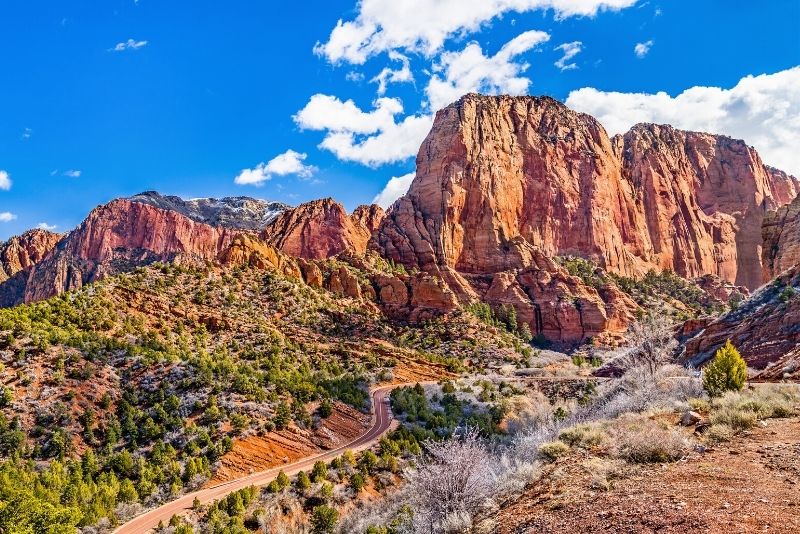
- Consider visiting during the off-season, which actually has many benefits. The park is less crowded, you’ll be able to drive yourself throughout the park, and finding accommodations will be easier.
- Set the alarm early no matter when you’re visiting. Parking lots fill up quickly at the park, and by mid-morning, the trails will be full as well. Arrive by 8 am to beat the crowds.
- Always put safety first. Carry lots of water with you, especially if you’re heading out for a backcountry trip, and never drink from rivers or bodies of water in the park. Make sure you check weather conditions before you head out for a trail. If there’s a risk of heavy rain or thunderstorms, it’s best to avoid The Narrows and other hikes where flash floods can occur.
- If you’re visiting during the high season (and especially summer), skip the Visitor Center – the lines are often very long. Everything you could need from there (maps, guides, and a list of potential warnings and tips) can also be found on the park’s website. Maps can even be downloaded to your phone.
- Avoid holiday weekends if possible. Memorial Day (May), Easter week, and Labor Day (September) are particularly crowded at the park.
- If you have your own car, don’t be afraid to explore the less-known areas of the park, including the Kolob Canyons, the park’s East Rim area, and the Zion–Mount Carmel Highway. These all offer stunning views, iconic scenery, and much thinner crowds.
Final Thoughts
With so much beauty to offer, Zion Canyon National Park is a destination not to miss in Utah. Whether you’re looking for an adventure-filled getaway or a relaxing trip to enjoy the natural beauty of the area, Zion has something for you.
Happy travels!

